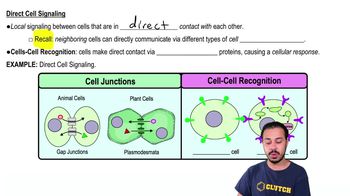Types of Cell Signaling exam Flashcards
 Back
BackTypes of Cell Signaling exam
1/29
Terms in this set (29)
- HomeostasisThe maintenance of stable internal conditions in an organism.
- Direct Cell SignalingLocal signaling between cells that are in direct contact with each other.
- Gap JunctionsJunctions that connect the cytoplasm of two animal cells, allowing exchange of nutrients and signaling molecules.
- What is the function of plasmodesmata in plant cells?Plasmodesmata connect the cytoplasm of plant cells, allowing them to exchange nutrients, materials, and signaling molecules.
- Cell to Cell RecognitionWhen cells make direct contact via membrane proteins, leading to a cellular response.
- Indirect Cell SignalingDistant signaling between cells that are not in direct contact, often using hormones.
- HormonesSignaling molecules released by a cell or gland that can travel and affect distant cells.
- Paracrine HormonesHormones that travel short distances and act on nearby cells.
- Endocrine HormonesHormones released into the bloodstream, traveling long distances to their target cells.
- What is synaptic signaling?A type of paracrine signaling where neurotransmitters are released across a synapse to activate a target cell.
- NeurotransmittersChemicals released by the end of a neuron to transmit a signal or convert it into a cell response.
- SynapseA small junction between the end of a neuron and another cell.
- What is the role of gap junctions in animal cells?They allow the exchange of nutrients and signaling molecules between connected cells.
- What is the difference between paracrine and endocrine signaling?Paracrine signaling acts on nearby cells, while endocrine signaling involves hormones traveling through the bloodstream to distant cells.
- Signal TransductionA series of events triggered by a receptor that leads to a cellular response.
- What is the main characteristic of direct cell signaling?It involves direct physical contact between the signaling and target cells.
- What is the main characteristic of indirect cell signaling?It involves signaling between cells that are not in direct contact, often using hormones.
- What is the function of neurotransmitters in synaptic signaling?They transmit signals across the synapse to activate the target cell.
- What is the role of cell junctions in direct cell signaling?They facilitate the direct exchange of signaling molecules and nutrients between neighboring cells.
- What is the target cell in cell signaling?The cell that receives the signal and generates a response.
- What is the role of membrane proteins in cell to cell recognition?They allow cells to recognize and respond to each other through direct contact.
- What is the main difference between gap junctions and plasmodesmata?Gap junctions are found in animal cells, while plasmodesmata are found in plant cells.
- What is the function of endocrine hormones?To travel through the bloodstream and signal distant target cells.
- What is the function of paracrine hormones?To signal nearby cells within the vicinity of their synthesis.
- What is the role of the synapse in synaptic signaling?It is the junction where neurotransmitters are released to transmit signals to the target cell.
- What is the importance of cell signaling in multicellular organisms?It is crucial for maintaining homeostasis and coordinating cellular activities.
- What is the role of the signaling cell in cell signaling?To release signaling molecules that affect the target cell.
- What is the role of the target cell in synaptic signaling?To receive neurotransmitters and generate a cellular response.
- What is the main function of cell signaling?To facilitate communication between cells to maintain homeostasis and coordinate functions.



